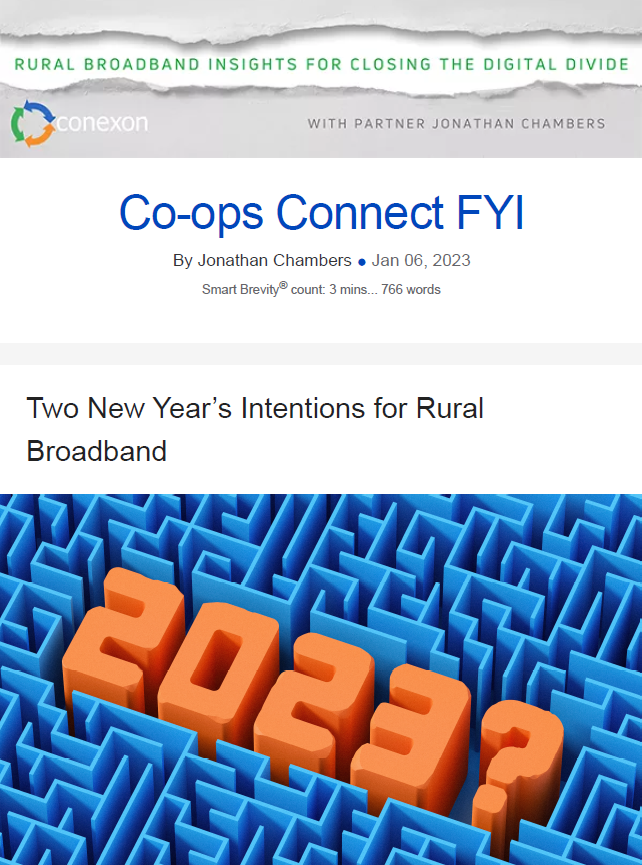Two New Year's Intentions for Rural Broadband
January 5, 2023
I’m not making resolutions for rural broadband. A resolution connotes you have some control over the outcome.
Instead, I am publicly stating my intent to pursue two legislative proposals for rural broadband.
Pursuing anything with a divided Congress may seem foolhardy, but:
- I spent many years helping draft and pass legislation when the federal government was divided.
- There are always legislative vehicles that offer opportunities (annual appropriations bills, an occasional farm bill, continuing resolutions).
The bottom line: A good idea, a House and a Senate champion, and you’re halfway home.
1. Make NTIA’s role in BEAD purely administrative
Where we are today:
- For the past 14 months, nearly $42.5 billion appropriated by Congress for rural broadband has been untouched. It is likely to remain untouched for another year because of delays at NTIA.
- During that time, most states have stood up broadband programs, reviewed applications, and awarded funds.
- Telecommunications companies, cable companies, electric cooperatives and other enterprises have participated, received funds, and constructed networks.
- The FCC, even a deadlocked FCC, took its funding from the Infrastructure Act and created the Affordable Connectivity Program.
The big picture:
NTIA, the principal administrator of BEAD, is a costly tollbooth on the route to rural broadband.
Go deeper:
- NTIA was charged with identifying high-cost areas in the country, allocating $4.25 billion to those high-cost areas, ensuring $100 million to all states and the US territories, and allocating the rest to states according to their number of locations lacking 25/3 Mbps using data supplied by the FCC.
- The FCC did its job. The rest is arithmetic.
- But from NTIA, crickets.
- NTIA managed only to put out a set of rules so convoluted even the most progressive professionals in the industry are aghast. (See Doug Dawson’s latest POTs and PANs post)
The bottom line:
NTIA’s rules will drive up the cost of constructing broadband by 25-50%, add enormous complexity and uncertainty, all without any discernible benefit.
- According to NTIA, each state must follow NTIA’s rules, rather than their own existing programs, before receiving funds appropriated by Congress for state programs.
My intention:
Change NTIA’s authority in BEAD to be strictly administrative.
- If a state has adopted a rural broadband program, approved by the governor, then NTIA shall approve the allocation of funds to the state.
- Such an approach will save years of waiting and billions of dollars of public funding.
2. Return RUS to its traditional role of lending to membership cooperatives
Where we are today:
- BEAD is a $42.5 billion rural broadband program.
- The FCC continues to spend $4.5 billion each year on high-cost areas for broadband.
- The American Rescue Plan Act, other FCC programs and state programs will contribute billions more.
- That adds up to more than $100 billion to be spent on rural broadband in the coming decade.
With $100 billion spent by states and the federal government’s expert agency on broadband, what is the role for the RUS ReConnect program?
The $2 billion ReConnect program is lost and, at times, counterproductive.
Go deeper with one telling example:
Central Virginia Electric Cooperative, an 85-year borrower from REA/RUS, was building a fiber network funded with an RUS smart grid loan.
- It was encouraged by RUS to apply for, and was awarded, a ReConnect grant.
- The fiber network funded by an RUS loan and the fiber network funded by a ReConnect grant used the same design and architecture, the same construction firm, and was merely a different feeder off the same substation.
- Yes, but: It took 2 years for RUS approval of the grant, which required layers of new bureaucracy and different sets of rules.
- When Central Virginia was encouraged by RUS to apply for a second grant, it took another 2 years.
- Unsurprisingly, Central Virginia is no longer applying for ReConnect grants.
The bottom line:
Something is amiss at RUS.
- Its predecessor agency, REA, was one of our country’s great institutions, supporting one of the country’s great, long-lasting economic marvels – the rural electric cooperative.
- Had the ReConnect program funded rural electrification, most of rural America would lack electricity.
My intention:
Return the RUS to its institutional roots.
- To reform the ReConnect program into a loan program for broadband, offering low-interest loans for member-owned cooperatives.
- To reintroduce the simplicity of the original rural electrification program.
What’s Next
How to make changes in 2023?
With legislative action.
The House and Senate will soon select members for:
- Agriculture Committees
- Commerce Committees
- Appropriations Committees and Subcommittees
That’s where our work will begin.

